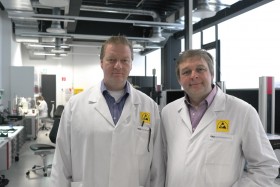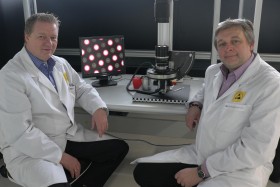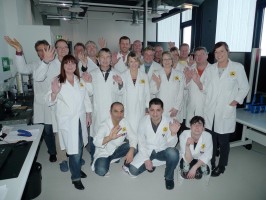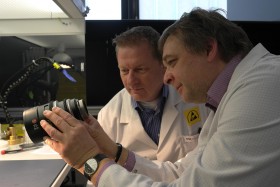There has been a lot of activity at Leica lately. Gerhard Baier is now Managing Director. He shares the title with Erik Feichtinger, who previously shared the title with Iain Neil. Gerhard will be responsible for production and marketing, Erik for finance and operations. Iain continues as principal lens designer and CTO of the Leica Summilux-C Project. Bernhard Kratzer is the new Production Manager, replacing Rainer Schnabel, who recently retired after 33 years at Leica. We spoke to Gerhard and Bernhard.
Jon Fauer: I guess you can answer the question on everyone’s mind: when are Leica Summilux-C lenses shipping?
Gerhard Baier: We have been totally excited and overwhelmed by the feedback and response of the market to the Leica Summilux-C lenses. Rarely in the industry there has been such a huge amount of orders before a product was delivered, and that made adjustments in the production process really necessary.
We are in the process of ramping up and restructuring the production process. These are lenses that have never been seen in the market before in regards to performance, size and weight. So it’s a completely new approach. We basically went through a learning curve on how to build, adjust, coat, and finish these lenses.
With these lenses, we raised the bar to a new level that was, I must say, a little bit unexpected in terms of production ability. With demands for perfection and fine-tuning of the lenses from the design into the industrial manufacturing process—some said we may have been too ambitious.
Perhaps. But without being ambitious, and I would rather call it a challenge, you’re not going to make any progress. This is our game and we want to claim that high end. This is what Leica stands for and what we do. I apologize to the market that it takes longer. There’s no excuse for the delay other than we really want to support the market with the best product.
This is our goal and this is what we are trying to do now. We are really making progress. The delay, even if it was long, is coming to an end. This spring, after NAB, we will start to deliver our lenses to the market in a larger quantity than up to now.
I trust it’ll be worth the wait.
Absolutely. It will be definitely be worth the wait. You get a lot of value for the money.
I have some tough questions. There is a perception about the design of the lenses being so ambitious that they are hard to make.
Yes, the design, made by Iain Neil, is ambitious. I call it challenging because we elevated lens manufacturing in regards to performance, weight and size to a new level. The whole concept of these lenses, envisioned by Christian Skrein, is challenging — and all the features of these lenses have not yet been fully recognized. We raised the bar for specifications and manufacturing tolerances. But meanwhile, we proved that we can make them, not in the time we had in mind, but we have shown that we can. Now we have to turn this into volume. And I think we are ready.
Bernhard Kratzer: I think the main point is to implement a more systematic production technique. What I found upon arriving at CW Sonderoptic was really more of a prototype assembly system that could make a limited number of lenses. It was time to bring the production up to a new level and say, “Okay, let’s re-organize and begin industrial production for big numbers.” And this is what we are doing. We will hire more people for production and expand the service department.
Gerhard Baier: When the project was started, the basic idea was to manufacture these lenses on an existing production line of still photography lenses at the Leica factory in Solms. However, it soon became clear that this could not be done. There was not enough capacity to use an existing Leica camera production line. They were totally back-ordered themselves, and didn’t have any time or room for us. So the first decision was to open a completely new production line just focused on this particular project of Summilux-C lenses. CW Sonderoptic built a dedicated assembly facility. But it was not big enough to satisfy the demand for the more than 200 sets that were ordered soon after the introduction of the lenses.
Nobody did this before. Unfortunately, or luckily, this meant really starting a company from scratch. This was not the basic idea when the optical and the mechanical designs were conceived at the very beginning of the project.
Originally the lenses were going to be made at the Leica Solms factory and then you moved production to Leitz Park?
Yes, because Leica Camera in Solms did not have the capacity to build all those lenses. The decision was very hard to make. It caused cost overages and time delays to open and set up a completely new production line for these cine lenses from scratch.
I assume that means you’re making the production area bigger or you’re moving again?
We are restructuring the process inside the building. By analyzing the workflow, we found that we can shorten the time a lens needs to be built. This is also to deal with the volume. We have delivered 20 sets to Otto Nemenz International. Now that we’re going to hit the big and demanding volume market, there needs to be action.
And are you changing production techniques?
In the production line, there is still a reserve that we can ramp up. But as Bernhard noted, we have to hire more people and we have to streamline the production process to make it leaner in order to get higher volume.
We have to go away from being a handmade manufacturer, as we were before, and this will, of course, change production techniques.
We have another topic that is affecting our assembly rate, and I think it is important to know. We started with a set of 8 lenses, but we realized that in the high-end area where we are playing this is not enough. We are introducing additional focal lengths. You will see two of them working at NAB, and more to come at IBC this year.
You said you’re going to hire more people. That seems to be the problem with a lot of lens manufacturers. Is it possible to get people?
Well, if you call people to work for Leica, as Bernhard and I have already done, there will be quite a few people who will answer that call. Leica is a very respected name. We’re looking for qualified people, trained people, but also we’re looking for some people for support services, logistics, shipping, inventory. We are looking not only for people who actually can build the lenses, but also to enlarge the entire team. This has to be more than hiring ten people and getting five more lenses a day. That is not how it works.
About service. Will you have a service facility in the US?
First of all, we are implementing a service facility here in Wetzlar, and yes, we will have service facilities in the US. The plan is to certify Band Pro as a Leica service facility for Summilux-C lenses in Los Angeles.
Bernhard, let’s talk about your background, where you came from, and how you got into this.
Bernhard Kratzer: I’m from Munich. I’m one of the rare few actually born in Munich—in 1966. I lived in Munich for the last 45 years. I attended school in Munich and then had an apprenticeship at Rodenstock as a precision mechanic and then as a master of precision mechanics and a master of business administration. I worked at Rodenstock for the last 30 years in a lot of departments.
First off, I built prototypes for optics in medical applications, photo optics, defense, and laser technologies. I built measurement and test equipment and I was involved in the design review process for a lot of products. One of those products was building and assembling the Vantage Zoom, the biggest Hawk 300-900 mm T4 anamorphic zoom.
I worked on a lot of processes and projects to optimize and improve coatings in all our business areas. Than I moved from the prototype department to the assembly department, including production logistics. The next step for me was to be responsible for the logistics process at Rodenstock. Now it’s called Qioptiq. My last job was being responsible for logistics at the entire factory in Munich for distribution, stock, inventory management, the assembly department, and the mechanical department.
That’s a very quick overview of my work over the past 30 years. I should also mention that I’m very interested in photography. It’s a big hobby of mine. The Leica brand in photography has always been the most prestigious name in the world, so I was very happy to be invited here. It didn’t take a long time for me to decide when they called. I hope I can do my very best at Leica to increase production and bring the products to a very high standard and high volume. I think I can.
Who convinced you to leave Munich and move to Wetzlar?
Bernhard Kratzer: I received a call from the COO of Leica, Markus Limberger. He also worked at Qioptiq for many years and is a friend of mine. Rainer Schnabel was retiring from the position after a lifetime with Leica, and they needed a new production manager here in Wetzlar. Then I had a long conversation with Christian Skrein, and after this it was a short process to decide and sign a contract.
What are some of the immediate things that you are going to be doing differently at Leica?
Bernhard Kratzer: I hope I can bring my past experience to the company. I had to change a lot of processes at Qioptiq and install a lot of systems, techniques and processes. Also, I had a lot of experience as a department head. I think I can bring that personal leadership experience here — to bring industrial standards to safely produce, build and assemble lenses to the highest levels.
Gerhard Baier: Maybe I can add something to what Bernhard just said. I think one of Bernhard’s jobs at Qioptiq was to define, restructure, and implement workflows and processes towards the specific product. So basically what he is doing with his experience is really appreciated here to ramp up Summilux-C production.
Gerhard, tell us about your background and how you wound up at Leica.
Gerhard Baier: I was born in 1964 in the south of Germany. I went to school and university. At university I studied economics. During this time, in order to afford the university, I got a job in a photo studio. I was always interested in photography all my life. I was photographer for our school newspaper and things like that.
While I was studying at the University of Augsburg, I also worked in their newly-opened video lab. So from still photography, by way of economics, I learned about motion pictures.
Next I got the chance (chance is an ironic way to say it) to go to Bosnia as a war reporter, cameraman, and editor for CNN, German TV and the BBC. I did that for over three years: 1991 to 1994.
From there, I wondered how to combine economics, motion pictures, and still photography. The Technical University of Berlin offered me a university career in media science where I could be, at the same time, both teacher and student. I got my second degree, a Masters in Media Science.
Also at University, I joined an English-speaking and French-speaking theater group. I gained some experience in drama that really helped me later to understand motion pictures not only from a technical perspective.
I moved to Munich because I fell in love with somebody there. I got a job as general manager of Media Rent, a rental house. This is how I stepped into HD. I bought the first Sony F900 camera in Germany when everyone was saying, ‘Gerhard is completely crazy—believing that high definition will be the next kind of image capture for digital cinematography.’ But after I bought an F900 camera, I wanted to learn how to tweak it to get a best picture out of it. We made some shorts and full-length feature films and we won some awards.
That’s how I met Amnon Band, from Band Pro Film & Digital, who offered me a job as a managing director for his Band Pro office in Munich that he wanted to open. That is how he managed to become my boss in 2002 and my friend later on.
I worked nearly ten years for Band Pro and this took me on an amazing journey pioneering HD and digital cinematography, driven by Santa Fe workshops, creating Europe’s biggest HD Event “Hands on HD” in Hannover, founding with two friends the “Digital Cinematography” Event, a two-day event in Munich, similar to Cine Gear, but smaller…
Weren’t you involved with ZEISS DigiPrimes?
That was an amazing project I came to when I first joined Band Pro. That was part of using the first F900 cameras and elevating digital cinematography. We were looking for lenses that worked like 35mm film lenses. Amnon Band and Zeiss were the force behind that.
It was totally amazing coming into the DigiPrime project at this very early stage and really create the DigiPrimes and DigiZooms together with all the participants.
Many cameras later, F23, F35, F65—I am now here at CW Sonderoptic with Leica because this is one of the most exciting projects I ever heard of.
After I heard about this project with the Summilux-C lenses, I was so excited that I said, “Okay, if somebody’s calling me, I may follow.” And this is basically what happened.
Who lured you to Leica?
I had a chat with Dr. Andreas Kaufmann, majority owner, and spoke a lot to the man who came up with the concept for the Leicas, Christian Skrein. So, in late January 2012 we came to terms.
You have 8 focal lengths now, right?
We learned and we saw pretty clearly that the market we are aiming for might not be satisfied with 8 lenses.
So we changed direction internally again. This is something that Bernhard is doing. He has to set up production now so that instead of doing a set of 8 lenses, we are now pushing additional focal lengths and expect to get them to the market earlier.
That will take away some capacity we actually would have had for producing sets of 8 lenses, but I think it’s a good decision. We are setting up the 29 and 65 mm. We will show prototypes at NAB. The first results we have are looking pretty amazing.
It’s like a mosaic. A lot of tiny little things coming together. First, capacity and inability to manufacture enough lenses at a Leica production line influenced the decision to set up our own manufacturing facility. Then we changed from a set with 8 lenses to 10 lenses and more. The 29 and 65 mm coming to NAB are planned to deliver towards IBC (September).
At IBC, you’re also going to see the 16 and 135 mm, which we are planning to deliver towards the end of the year.
What else slowed you down?
We had some mechanical issues. We changed parts. We found better ways to do it, make it easier to build, but it slowed us down. We underestimated at the time, when we first showed the Summilux-C lenses at NAB 2010. That’s true, yes.
Will there be additional or other sets of Leica lenses?
We are looking into all kinds of options and I think it’s worth keeping an eye on us. We are definitely thinking of creating a family of cine lens products. We are exploring some options. I am not giving too much away by telling you to see us at IBC time. Save the date. Stay tuned.
I look forward to exhibiting our set of 10 Leica Summilux-C lenses at NAB in the Band Pro booth, C10308.











